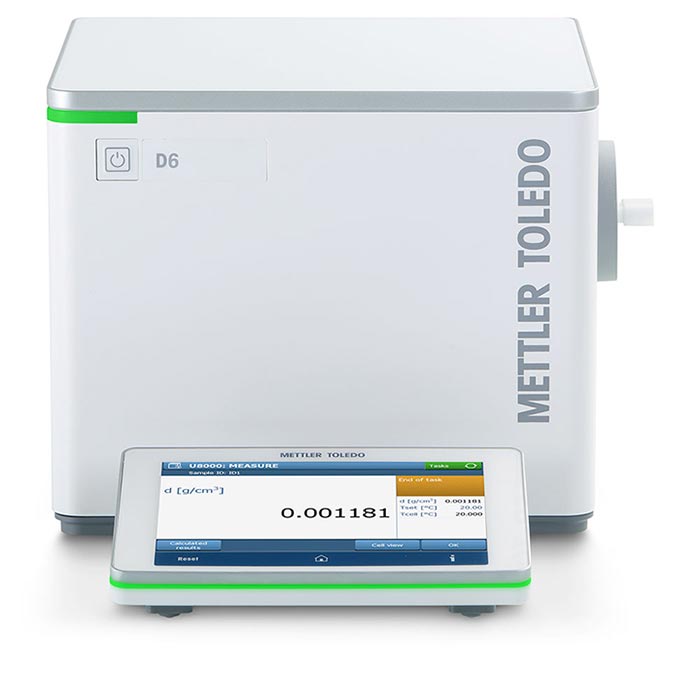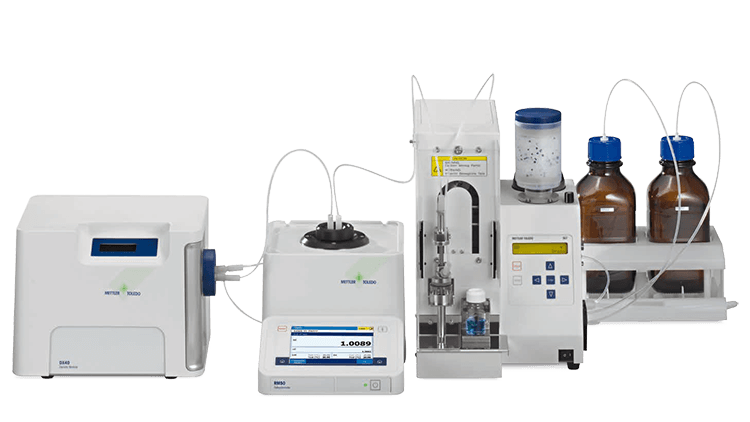Reports
Density Measurement: Best Operating Practices for the Laboratory
The latest advances in digital technologies allow users to perform a density measurement with a high degree of precision and great resolution. To maximize the accuracy of results, however, users may benefit by applying the best operating practices described in this article.
Advantages of Digital Automatic Density Measurement
Digital density meters typically use electromagnetically-induced oscillation U-tube technology to measure the density of a liquid sample. The oscillation frequency of the U-tube is proportional to the mass of the sample, resulting in an accurate density value through the measurement of the vibration frequency of the U-tube. The frequency is measured by a sensor and the density is calculated through a relevant equation. As the density of liquid is dependent on the measuring temperature, modern density meters use Peltier thermostats (devices that allow a user to heat and cool simultaneously at the same place) to control the temperature – this allows the temperature of the sample to remain stable over time.
Concentrations of samples can also be determined with the density measurement, so long as the relevant relationship is known. Benchtop density meters can store data of known sample concentrations, and then pair the corresponding densities and concentrations.
Advantages over manual methods include:
- Less than 2mL sample volumes of liquid
- Fast measurements (under 1 minute)
- High accuracy
- Independent of operator error
- Automation
- High throughput
Instrument Verification
Frequent recalibrations (adjustments) of these instruments are normally not recommended since improperly done adjustments could aggravate measurement errors. The best approach is instead to verify the instrument accuracy at regular intervals using suited Density Standards. The most commonly used standard is deionized (De-I) water (which has a value of 0.99 gr/cm3). Additionally, to verify correct operation in a defined range, other standards commonly used include:
- Dodecane (0.75 gr/cm3)
- 2.4 dichlorotoluene (1.25 gr/cm3)
- 1-bromonaputalene (1.48 gr/cm3)
Density Measurement Tolerances
Mettler Toledo D Series Instruments provide high resolution and accurate results when the appropriate operation guidelines are followed. Scientists or Lab Managers can program the right Tolerance (as per their internal SOP and instrument resolution) and the D Series will alert the user if that Tolerance is being exceeded. The recommended criteria to establish the Tolerance is based on the instrument’s resolution and operator repeatability. If using De-I water as a standard, the Tolerance should be defined as 2 times the instrument resolution plus the repeatability. The repeatability is defined as the standard deviation experienced by the operator when measuring the same sample three times on a raw.
For example, in the case of the model D4 (which has a resolution of 0.0001 gr/cm3), using the proper techniques, the user repeatability should not exceed the instrument resolution (is normally half of that value). Doing this density measurement under the same conditions in De-I water should provide a repeatability of 0.00005 gr/cm3. In this case, the maximum Tolerance should be established as (2 x 0.0001 + 0.00005) gr/cm3. Rounding the result of this calculation, for this example, the Tolerance should be set at 0.0003 gr/cm3.
In the case of using certified Organic Solvent Standards, it is important to consider the temperature effects since these standards are very temperature dependent. For example, the 2-4 dichlorotoluene decreases 0.0105 gr/cm3 from 15 C to 25 C. In summary, the 4 factors that need to be considered to establish a Tolerance when using Organic Solvent Standards are:
- Instrument limit of error (3x instrument resolution)
- Standard uncertainty
- Temperature error
- Repeatability

Available through PROAnalytics: Density Meter (benchtop & handheld)
For this example, using the Mettler Toledo D5 Series instrument, the Tolerance using a 2-4 dichlorotoluene standard would be calculated as:
Limit of error: +/- 0.00003
Std. uncertainty: +/- 0.00003
Temp. error: +/- 0.00002
(Note: Temp. Error is calculated as Instrument Temp accuracy x Org Solvent Temp Coefficient = 0.02 C x 0.0105 gr/cm3 = 0.00002)
Repeatability: +/- 0.00001 (This is a typical example, it should be determined by the user)
In this example, the Tolerance should be established as the addition of the 4 above components resulting as 0.00009 gr/cm3.
Investigation on sources of errors
Potential sources of errors that could result in exceeding the set Tolerance could include:
- Degraded or incorrect standard being used
- Dirty or wet chambers are a major source of error. Make sure density measurement cell is completely clean and dry. In some instances, deposits of previously measured samples are not always visible. To determine whether samples such as oil or fat have deposited on the chamber, simply measure the density of air and density of water (distilled water). If the density of air is too high and that of water is too low, the chamber has not been thoroughly cleaned.
- Air bubbles in the measuring chambers can frequently cause errors in density measurement. Bubbles can form when the sample degasses, or can be introduced with the sample. Warming the sample in a closed vessel can allow the viscosity of a sample to decrease, and release air bubbles.
- Sample viscosity can also affect measurement values, as the oscillating technique was originally created to measure the density of less viscous samples. Typically, the density values of high-viscosity samples can result in higher measurement values. This is due to the oscillation being damped by the shear forces of the viscous samples, providing a much lower frequency reading.
- Measurement errors can occur when highly concentrated samples cool in the chamber, causing crystallization. Also, if solutions are allowed to stand for long periods of time, solid material may settle. Stir the sample before placing it in the measuring chamber. Be careful not to create any air bubbles during this process.
A final calibration Adjustment could be performed only when consistent repeatable results are being obtained.
Calibration (Adjustment)
When the Tolerance test fails after attempting it several times and cleaning the Cell does not remediate the situation, an Adjustment is required.
To assure complete cleanliness and dryness, the Cell must be rinse with a highly volatile solvent (i.e. Acetone) followed by a 3 minute exposure to dry instrument air.
This step it is very important. Otherwise, if the chamber was not completely dry, the presence of water films would cause a wrong zero (when adjusted with air) and the resulting slope would be wrong as well.
After a calibration/adjustment has been completed, always test the instruments with certified standards to confirm proper operation within established Tolerances.
Sampling
Manual Sampling must be done with a Syringe (3 component w/O-ring style). Always inject at least 1.5 the chamber volume to displace any possible residual liquid that remained stagnant in the chamber to eliminate any contamination. Since Manual sampling is operator dependent, it is always preferable to implement automated sampling when possible.
Automatic Filling Systems ensure sampling is done in the most reproducible fashion, maximizing consistency of results. Mettler Toledo offers the SC1 and SC30 automatic filling stations. Depending on the fluid viscosity, the sampling speed can be easily programmed on these instruments.

